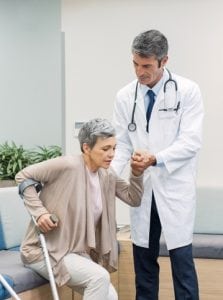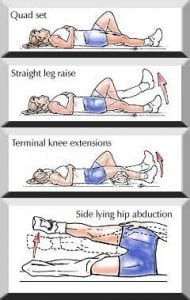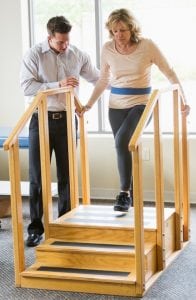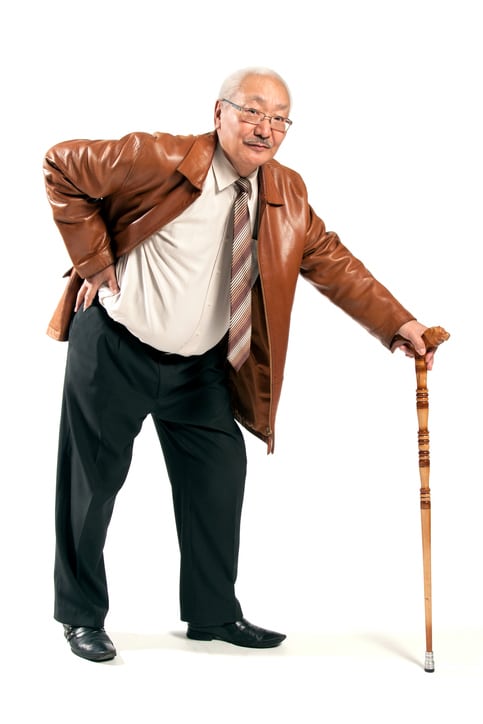Are you considering joint replacement surgery? Read how we can help you prepare and recover!
This time of year is a popular time to consider having a hip or knee replacement – in the hope you will be fit in time for summer!
Many of our clients end up having both knees or both hips operated on and it’s noticeable how much quicker they recover after the second. This is usually because they know what to expect and are already familiar with the exercises and rehab that is required.
For this reason we would urge anyone considering the operation for the first time to come and see us about 3-4 months beforehand so that we can do some ‘prehab’. We can make sure they are as good as they can be before surgery and are fully informed about what the surgery and rehab will entail. Forewarned is forearmed!
What are the effects of having osteoarthritis?

Difficulty rising from a chair
Most clients awaiting surgery have had osteoarthritis in their joint for some years. The disease causes the following things to happen:
- the muscles surrounding the joint become weakened and wasted
- they lose some of their range of movement because of stiffness of the joint
- the surrounding ligaments and muscles often tighten up further restricting movement
- the pain and weakness causes the person to limp and usually limits their walking distance. They often resort to a stick or crutch.
- Everyday activities such as getting up from a chair or ascending and descending stairs become harder to do
- With activity levels limited people often take less exercise and put on weight which becomes a vicious cycle
How can Physiotherapy prehab help?
 We carry out a comprehensive assessment of your range of movement, muscle strength, walking gait, posture and ability to do everyday activities. From this we can tailor a programme of exercises that will help to:
We carry out a comprehensive assessment of your range of movement, muscle strength, walking gait, posture and ability to do everyday activities. From this we can tailor a programme of exercises that will help to:
- build back some muscle strength in your trunk, hip and knee
- allow you to become familiar with the exercises that you will need to do after surgery
- where possible restore some movement in your joint
- improve your walking pattern and learn what a normal gait is and what you should concentrate on after surgery. Even practise using crutches in advance of your surgery
- practise everyday activities and become better at performing them, as you gain more strength and flexibility
If you have limped for some time you tend to forget the normal way of walking as the limp becomes a learnt habit. People normally limp because they are in pain and because their muscles are weak. If you can strengthen the muscles that support the arthritic joint then the pain is often reduced and walking becomes easier.
We also give advice on:
- footwear to reduce stress through the arthritic joint
- some clients require an appointment with our podiatrist who can help them correct foot posture that may be having an adverse affect on their hip or knee – for example excessively rolling your ankle in or out too much
- the benefits of low impact exercise which, although may be painful, does not have a harmful effect on the joint and will not make the disease any worse
- the benefits of keeping your weight under control to reduce stress in the arthritic joint
- what to expect after your surgery and a plan of how your rehab will progress
We do sometimes find that clients postpone their surgery as a result of working on their prehab particularly if they have not had Physiotherapy before being offered surgery!
Your post-op rehab
 Sadly in many NHS hospitals patients are discharged with little or no Physiotherapy help with their rehab. It’s absolutely essential that the muscles surrounding the joint have their strength restored if you are to get the most potential from your new hip or knee. We see many clients who come to see us a year after surgery and who have failed to regain their movement and are struggling with everyday activities due to poor muscle strength.
Sadly in many NHS hospitals patients are discharged with little or no Physiotherapy help with their rehab. It’s absolutely essential that the muscles surrounding the joint have their strength restored if you are to get the most potential from your new hip or knee. We see many clients who come to see us a year after surgery and who have failed to regain their movement and are struggling with everyday activities due to poor muscle strength.
The muscles that surround the hip and knee are some of the largest in the body. They waste very quickly and need focused attention to be restored to their former glory! They are the muscles that get you up from sitting, help you walk along the flat and up and down hills and help you climb the stairs. When these muscles are not retrained it’s common to develop lower back pain as the back will take much of the strain.
Retraining your walking pattern so you can shed your crutch or stick is an urgent priority. We will teach you drills to get you from climbing stairs one step at a time to climbing them normally. Our aim is to break all these tasks down into bite sized pieces and gradually progress the difficulty until you master the skill in question.
To book an appointment with one of our Physio team just:
Call 020 8876 5690
Contact us by email here
Or just pop in for a chat!



